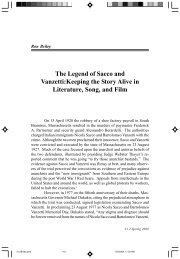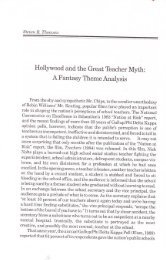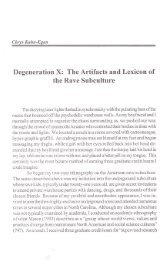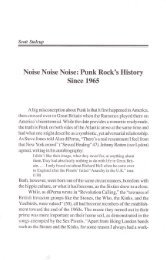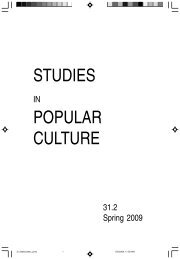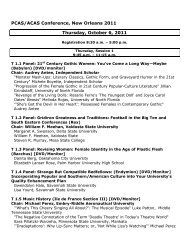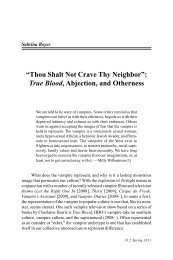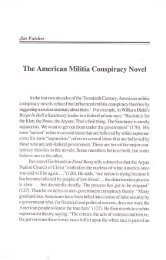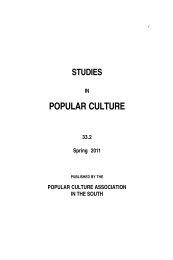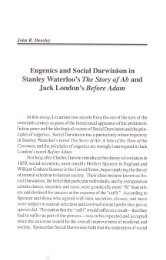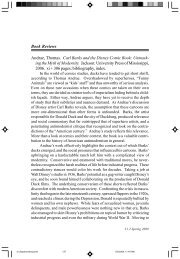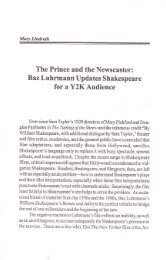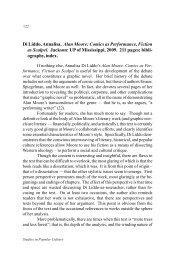Rooting for the Bad Guy: - Popular/American Culture Association in ...
Rooting for the Bad Guy: - Popular/American Culture Association in ...
Rooting for the Bad Guy: - Popular/American Culture Association in ...
You also want an ePaper? Increase the reach of your titles
YUMPU automatically turns print PDFs into web optimized ePapers that Google loves.
Richard Keen, Monica L. McCoy, Elizabeth Powell<br />
<strong>Root<strong>in</strong>g</strong> <strong>for</strong> <strong>the</strong> <strong>Bad</strong> <strong>Guy</strong>:<br />
Psychological Perspectives<br />
My ex is a werewolf. I was young, he was a bad boy.<br />
Everybody said no, so I said yes. I am a cliché.<br />
--Luna Garza (Jan<strong>in</strong>a Gavankar) <strong>in</strong> True Blood (2008 - ),<br />
“I’m Alive and on Fire”<br />
Imag<strong>in</strong>e watch<strong>in</strong>g <strong>the</strong> news and hear<strong>in</strong>g <strong>the</strong> anchorperson<br />
describe how eleven men stole $150 million. Would you hope <strong>the</strong>y<br />
would never get caught? What if <strong>the</strong> news story was about a mob boss<br />
who successfully plotted to kill multiple people who had “wronged”<br />
him, <strong>in</strong>clud<strong>in</strong>g his older bro<strong>the</strong>r and a police capta<strong>in</strong>? Unless you<br />
are a sociopath, you probably want <strong>the</strong>se crim<strong>in</strong>als apprehended and<br />
punished. However, even if you are a normal, well-adjusted person,<br />
<strong>the</strong> odds are that you rooted <strong>for</strong> people committ<strong>in</strong>g <strong>the</strong>se or similar<br />
acts. In Ocean’s 11 (2001), most of us wanted Danny Ocean (played<br />
by George Clooney) and his crew to successfully rob three cas<strong>in</strong>os of<br />
$150 million. Similarly, <strong>in</strong> The Godfa<strong>the</strong>r (1972) and The Godfa<strong>the</strong>r<br />
II (1974), many of us wanted Michael Corleone (played by Al Pac<strong>in</strong>o)<br />
to do what he deemed necessary. What is it about <strong>the</strong>se law breakers<br />
that makes us root <strong>for</strong> <strong>the</strong>m?<br />
When watch<strong>in</strong>g a melodrama, <strong>the</strong> audience is encouraged to<br />
cheer <strong>for</strong> <strong>the</strong> hero and boo when <strong>the</strong> villa<strong>in</strong> appears. This certa<strong>in</strong>ly<br />
makes sense: we should root <strong>for</strong> those who do good deeds and<br />
disparage those who do bad th<strong>in</strong>gs. How <strong>the</strong>n do we understand <strong>the</strong><br />
proliferation <strong>in</strong> popular culture of <strong>the</strong> beloved villa<strong>in</strong>? Why do so<br />
many seem<strong>in</strong>gly normal, well-adjusted people root <strong>for</strong> <strong>the</strong> bad guy?<br />
Our goal <strong>for</strong> this paper is to expla<strong>in</strong> <strong>the</strong> appeal of <strong>the</strong> bad guy from a<br />
psychological perspective.<br />
First, we need to def<strong>in</strong>e what is meant by <strong>the</strong> phrase “bad<br />
guy.” There is not any fully agreed-upon list of criteria that designates<br />
who is a bad guy and who is not. Questions about motivation, past<br />
experiences, and consequences all figure <strong>in</strong>to decid<strong>in</strong>g whe<strong>the</strong>r<br />
someone is seen as bad. There is general agreement that bad guys<br />
Studies <strong>in</strong> <strong>Popular</strong> <strong>Culture</strong> 34.2 Spr<strong>in</strong>g 2012<br />
129
The Psychology of <strong>Root<strong>in</strong>g</strong> <strong>for</strong> <strong>the</strong> <strong>Bad</strong> <strong>Guy</strong><br />
break society’s conventions or rules. However, <strong>the</strong> question of<br />
whe<strong>the</strong>r all people who break <strong>the</strong> rules are bad is more complex. For<br />
<strong>in</strong>stance, W<strong>in</strong>ston Smith <strong>in</strong> Orwell’s 1984 (1949) breaks <strong>the</strong> rules, but<br />
few consider him to be a bad man. Even though W<strong>in</strong>ston deliberately<br />
violates <strong>the</strong> law by committ<strong>in</strong>g thought crimes and engag<strong>in</strong>g <strong>in</strong> an<br />
illegal affair, nearly all readers root <strong>for</strong> him and not <strong>for</strong> <strong>the</strong> officials<br />
who “rehabilitate” him so that he comes to embrace <strong>the</strong> teach<strong>in</strong>gs of<br />
Big Bro<strong>the</strong>r. Or consider A Time to Kill (1996) where a ten-year-old<br />
black girl, Tonya, is raped and beaten by two White supremacists.<br />
Afraid that <strong>the</strong> men will be acquitted, Tonya’s fa<strong>the</strong>r, Carl Lee, enters<br />
<strong>the</strong> courthouse and shoots both men to death and <strong>in</strong>jures an <strong>in</strong>nocent<br />
deputy. To many, nei<strong>the</strong>r W<strong>in</strong>ston nor Carl Lee are bad guys, even<br />
if <strong>the</strong>y broke <strong>the</strong> rules. But <strong>the</strong>n <strong>the</strong> question is, where do you draw<br />
<strong>the</strong> l<strong>in</strong>e? Is it okay to break rules if <strong>the</strong>y are unfair, or if you have<br />
been hurt, or if you only hurt bad people? We have concluded that <strong>the</strong><br />
construct of “<strong>the</strong> bad guy” is actually complex and multi-dimensional.<br />
For example, one dimension <strong>in</strong> this construct centers on rule-break<strong>in</strong>g.<br />
At one end of this spectrum are <strong>the</strong> “bad boy” personas who break<br />
societal rules <strong>for</strong> no apparent reason and at <strong>the</strong> o<strong>the</strong>r extreme are<br />
those who break societal rules because <strong>the</strong> rules are unjust. Ano<strong>the</strong>r<br />
dimension centers on <strong>the</strong> context <strong>in</strong> which <strong>the</strong> bad behavior occurs.<br />
Is <strong>the</strong> bad behavior conf<strong>in</strong>ed to a certa<strong>in</strong> situation or is it pervasive?<br />
There are many additional dimensions, with each bad guy hav<strong>in</strong>g a<br />
unique comb<strong>in</strong>ation of dimensional locations <strong>in</strong> this conceptual space.<br />
Fundamental Attribution Error<br />
I’m not bad. I’m just drawn that way.<br />
--Jessica Rabbit (Kathleen Turner) <strong>in</strong> Who Framed Roger<br />
Rabbit? (1988)<br />
The fundamental attribution error is <strong>the</strong> tendency to attribute<br />
ano<strong>the</strong>r person’s behavior to <strong>the</strong>ir <strong>in</strong>ternal characteristics as opposed<br />
to <strong>the</strong> situation <strong>the</strong>y are <strong>in</strong> at <strong>the</strong> time (Kass<strong>in</strong>, Fe<strong>in</strong>, and Markus<br />
118). There<strong>for</strong>e, if I see a stranger shoot ano<strong>the</strong>r person, I am likely<br />
to assume that he is an evil person with questionable morals. On <strong>the</strong><br />
o<strong>the</strong>r hand, if I shoot someone, I am much less likely to th<strong>in</strong>k that it is<br />
because I am evil and immoral. I would be quick to expla<strong>in</strong> that I fired<br />
<strong>the</strong> gun to protect myself and my family from repeated threats that I<br />
had received from <strong>the</strong> person I shot. I make an <strong>in</strong>ternal attribution<br />
about <strong>the</strong> stranger and an external attribution (i.e., situational) about<br />
myself. This is especially true if <strong>the</strong> behavior <strong>in</strong> question is negative.<br />
Follow<strong>in</strong>g this well-established phenomenon, one would tend<br />
130 Studies <strong>in</strong> <strong>Popular</strong> <strong>Culture</strong> 34.2 Spr<strong>in</strong>g 2012
to th<strong>in</strong>k that if I see a character behav<strong>in</strong>g badly <strong>in</strong> a film, <strong>the</strong>n I should<br />
th<strong>in</strong>k that he is a bad person and <strong>the</strong>re<strong>for</strong>e, I should not f<strong>in</strong>d him<br />
appeal<strong>in</strong>g. This is not, however, <strong>the</strong> way it tends to play out. Most<br />
of us are drawn to <strong>the</strong> bad guy and f<strong>in</strong>d ourselves excus<strong>in</strong>g his or her<br />
behavior. This can be partially expla<strong>in</strong>ed by realiz<strong>in</strong>g that <strong>the</strong> types<br />
of attributions we make are <strong>in</strong>fluenced by how much <strong>in</strong><strong>for</strong>mation we<br />
have about <strong>the</strong> actor (Green, Lightfoot, Bandy and Buchanan 164).<br />
If you hear about someone on <strong>the</strong> news who does someth<strong>in</strong>g bad,<br />
you can immediately th<strong>in</strong>k, “He (or she) is a bad person.” All you<br />
know about <strong>the</strong> person is <strong>the</strong> behavior <strong>in</strong> this <strong>in</strong>stance, so it is an easy<br />
conclusion to make. You have no <strong>in</strong><strong>for</strong>mation about <strong>the</strong> situation he or<br />
she was fac<strong>in</strong>g that might <strong>in</strong>fluence your attribution.<br />
Research has shown that if participants are exposed to short,<br />
10-m<strong>in</strong>ute clips of an actor behav<strong>in</strong>g as ei<strong>the</strong>r a good man or an evil<br />
one, <strong>the</strong>y will later rate <strong>the</strong> actor himself more positively if <strong>the</strong>y saw<br />
<strong>the</strong> character’s good behavior and more negatively if <strong>the</strong>y saw <strong>the</strong><br />
character’s evil behavior (Tal-Or and Papirman 336). In o<strong>the</strong>r words,<br />
<strong>the</strong> participants were mak<strong>in</strong>g a version of <strong>the</strong> fundamental attribution<br />
error. Because <strong>the</strong>y had only a brief sample of behavior to analyze,<br />
<strong>the</strong>y assumed what <strong>the</strong>y saw was reflective of not just <strong>the</strong> character,<br />
but also <strong>the</strong> actor’s personality. In fact, almost all of <strong>the</strong> research<br />
on <strong>the</strong> fundamental attribution error has focused on how one makes<br />
attributions about a stranger. If a mysterious stranger appears from<br />
out of nowhere and attacks a character we know and love, it is likely<br />
that we will make <strong>the</strong> fundamental attribution error. We will assume<br />
that he is a bad man. However, <strong>the</strong> villa<strong>in</strong>s we root <strong>for</strong> are generally<br />
not strangers to us; we know a great deal about <strong>the</strong>m—from narration,<br />
from flashbacks, or because <strong>the</strong>y talk to <strong>the</strong>mselves and we get to<br />
listen. This is especially true if we have been watch<strong>in</strong>g someone <strong>in</strong><br />
a series <strong>for</strong> years. We know a great deal about how <strong>the</strong> situation is<br />
<strong>in</strong>fluenc<strong>in</strong>g him. It allows us to be as k<strong>in</strong>d to him as we generally are<br />
to ourselves.<br />
For example, consider Spike from Buffy <strong>the</strong> Vampire Slayer<br />
(1997 - 2003). He is a soulless vampire who delights <strong>in</strong> mock<strong>in</strong>g,<br />
tortur<strong>in</strong>g, and kill<strong>in</strong>g people. On <strong>the</strong> surface, this should not be an<br />
appeal<strong>in</strong>g character. However, many women and men who watch<br />
<strong>the</strong> show pick him as <strong>the</strong>ir favorite character. While it is true that he<br />
does very bad th<strong>in</strong>gs, you learn a lot about why over <strong>the</strong> course of <strong>the</strong><br />
series. Spike was ridiculed as a young man; he was rejected by his first<br />
love and his mo<strong>the</strong>r; he is now <strong>in</strong> love with a woman he cannot have.<br />
Wouldn’t this make any of us want to kill someone? As we learn about<br />
131
The Psychology of <strong>Root<strong>in</strong>g</strong> <strong>for</strong> <strong>the</strong> <strong>Bad</strong> <strong>Guy</strong><br />
a bad guy, we shift from mak<strong>in</strong>g snap judgments based on <strong>in</strong>ternal<br />
attributions, to assessments that take external factors <strong>in</strong>to account.<br />
The result of situational knowledge about a villa<strong>in</strong> impact<strong>in</strong>g<br />
<strong>the</strong> way we <strong>in</strong>terpret behavior is not new, nor is it true only <strong>for</strong> adults.<br />
Take, <strong>for</strong> <strong>in</strong>stance, two popular children’s books published <strong>in</strong> <strong>the</strong> early<br />
1960s by Mary Stolz: A Dog on Barkham Street (1960) and The Bully<br />
of Barkham Street (1963). The first book published, A Dog on Barkham<br />
Street, tells <strong>the</strong> story of a sweet young boy named Edward who wants<br />
a dog more than anyth<strong>in</strong>g else. Edward has a generally happy life,<br />
except <strong>for</strong> <strong>the</strong> presence of Mart<strong>in</strong>, <strong>the</strong> bully next door. Mart<strong>in</strong> is an<br />
overweight older boy who picks on Edward, calls him names like<br />
“Weird One,” knocks his bike over, pushes him to <strong>the</strong> ground, and<br />
makes him say, “uncle.” As you read this book, you identify fully with<br />
Edward, and feel disgust toward Mart<strong>in</strong>. Three years later, The Bully<br />
of Barkham Street was published. It tells <strong>the</strong> same story from <strong>the</strong> po<strong>in</strong>t<br />
of view of Mart<strong>in</strong>, <strong>the</strong> bully. Now you learn that Mart<strong>in</strong>’s parents are<br />
overworked, pay little attention to him, and seem to prefer his sister.<br />
Mart<strong>in</strong> struggles with school work and is embarrassed by his weight.<br />
The sweet Edward from book one is shown as a boy who teases Mart<strong>in</strong><br />
with taunts of “Fatso” and “Plump Pudd<strong>in</strong>g.” Mart<strong>in</strong> knows that he<br />
acts like a bully at times when he is angry and frustrated, but he tries<br />
to change. Un<strong>for</strong>tunately, he is surrounded by adults and children who<br />
always assume <strong>the</strong> worst of him. By <strong>the</strong> end of book two, your attitude<br />
toward <strong>the</strong> villa<strong>in</strong> has shifted from one of disgust to one of empathy.<br />
It is easy to put yourself <strong>in</strong> Mart<strong>in</strong>’s shoes and see what has caused his<br />
negative behaviors. In o<strong>the</strong>r words, you stop mak<strong>in</strong>g <strong>the</strong> fundamental<br />
attribution error, and f<strong>in</strong>d yourself root<strong>in</strong>g <strong>for</strong> <strong>the</strong> bad guy.<br />
The idea that our perception of o<strong>the</strong>rs changes as we learn about<br />
<strong>the</strong>ir circumstances is closely related to <strong>the</strong> concept of identification.<br />
When you empathize with someone and put yourself <strong>in</strong>to his or her<br />
position by shar<strong>in</strong>g his or her perspective, you are identify<strong>in</strong>g with that<br />
person. Accord<strong>in</strong>g to Jonathan Cohen, “while strongly identify<strong>in</strong>g, <strong>the</strong><br />
audience member ceases to be aware of his or her social role as an<br />
audience member and temporarily (but usually repeatedly) adopts <strong>the</strong><br />
perspective of <strong>the</strong> character with whom he or she identifies” (251).<br />
Early <strong>the</strong>orists po<strong>in</strong>ted out that <strong>the</strong> process of identification is not<br />
always a deliberate, willful act. Bruno Bettelheim noted that prisoners<br />
may identify with <strong>the</strong>ir captors by com<strong>in</strong>g to accept <strong>the</strong>ir views of<br />
<strong>the</strong> world as a means of survival (Cohen 248). This practice would<br />
suggest we do not need to like people or believe <strong>the</strong>y are good <strong>in</strong> order<br />
to identify with <strong>the</strong>m. There<strong>for</strong>e, we could identify with a villa<strong>in</strong> even<br />
132 Studies <strong>in</strong> <strong>Popular</strong> <strong>Culture</strong> 34.2 Spr<strong>in</strong>g 2012
if we did not th<strong>in</strong>k <strong>the</strong> person was good, and, subsequently feel more<br />
empathy as we <strong>in</strong>ternalized his or her world-view and began to consider<br />
events from that perspective. However, given that we do not need to<br />
identify with media bad guys <strong>in</strong> order to survive, what starts viewers<br />
down this road? Cohen (250-252) suggested that features of texts and<br />
films are designed to elicit identification. The use of camera angles <strong>in</strong><br />
films sets up <strong>the</strong> viewpo<strong>in</strong>t of <strong>the</strong> audience member and first-person<br />
narration helps to put <strong>the</strong> reader <strong>in</strong>to <strong>the</strong> m<strong>in</strong>d of <strong>the</strong> author’s chosen<br />
character. Television directors often manipulate audience members’<br />
po<strong>in</strong>t of view by us<strong>in</strong>g different film<strong>in</strong>g techniques. Accord<strong>in</strong>g to<br />
Fiske (6), close-up shots are used to “sw<strong>in</strong>g our sympathy away<br />
from” <strong>the</strong> characters whom we are not <strong>in</strong>tended to identify with. In<br />
ei<strong>the</strong>r <strong>for</strong>mat, <strong>the</strong> creator can opt to direct you toward identify<strong>in</strong>g with<br />
a character who is a bad guy. It would seem to follow, <strong>the</strong>n, that<br />
<strong>the</strong> more an audience member identifies with a character, <strong>the</strong> more<br />
<strong>for</strong>giv<strong>in</strong>g <strong>the</strong>y would be of <strong>the</strong> character’s actions and <strong>the</strong> more likely<br />
<strong>the</strong>y would be to attribute those actions to external circumstances.<br />
Time Delay<br />
An additional aspect of <strong>the</strong> fundamental attribution error<br />
that needs to be considered is <strong>the</strong> time delay between <strong>the</strong> event and<br />
<strong>the</strong> attribution. Research has shown that while people make <strong>the</strong><br />
fundamental attribution error immediately after an event occurs, it<br />
decl<strong>in</strong>es when people are questioned about <strong>the</strong> event days or months<br />
after it occurred (Burger 184; Truchot, Maure and Patte 206).<br />
While research directly test<strong>in</strong>g time delay and attributions<br />
made about movie and television villa<strong>in</strong>s does not exist, this<br />
relationship may expla<strong>in</strong> some of <strong>the</strong> appeal of fictional “bad guys.”<br />
Even if we are <strong>in</strong>itially disapprov<strong>in</strong>g of <strong>the</strong>m <strong>for</strong> what we see, this<br />
may fade with time as we have <strong>the</strong> opportunity to reflect on <strong>the</strong><br />
situational factors that might have driven <strong>the</strong> negative behavior. This<br />
time to reflect is likely an important piece of <strong>the</strong> puzzle because it has<br />
been noted that mak<strong>in</strong>g attributions is a three-stage process. First, an<br />
observer identifies someone else’s behavior and, second, <strong>the</strong> observer<br />
makes a personal attribution. These two th<strong>in</strong>gs happen automatically.<br />
It is only <strong>in</strong> <strong>the</strong> third stage, with thought and attention, that observers<br />
are able to consider <strong>the</strong> role of <strong>the</strong> situation and make adjustments to<br />
<strong>the</strong>ir <strong>in</strong>itial attribution (Tal-Or and Papirman 333). Perhaps this means<br />
that those of us who are drawn to <strong>the</strong> bad guy can say it means we are<br />
th<strong>in</strong>k<strong>in</strong>g more deeply about <strong>the</strong> causes of his or her behavior.<br />
133
The Psychology of <strong>Root<strong>in</strong>g</strong> <strong>for</strong> <strong>the</strong> <strong>Bad</strong> <strong>Guy</strong><br />
Mere Exposure Effect<br />
All right, George, I’ll be honest, <strong>the</strong> first time we went out, I<br />
found you very irritat<strong>in</strong>g, but after see<strong>in</strong>g you <strong>for</strong> a couple of times,<br />
you sorta got stuck <strong>in</strong> my head, Costanza!<br />
--Hea<strong>the</strong>r (Kimberly Kalil) on Se<strong>in</strong>feld (1990 – 1998),<br />
“The Chicken Roaster”<br />
While <strong>the</strong> suppression of <strong>the</strong> Fundamental Attribution Error<br />
can help to expla<strong>in</strong> <strong>the</strong> appeal of <strong>the</strong> bad guy, <strong>the</strong>re are many o<strong>the</strong>r<br />
psychological phenomena that also shed light on <strong>the</strong> topic. Accord<strong>in</strong>g<br />
to <strong>the</strong> mere exposure effect, <strong>the</strong> more often you are exposed to a<br />
stimulus, <strong>the</strong> more you like it (Zajonc 2). This is true <strong>for</strong> everyth<strong>in</strong>g<br />
from what letters we prefer to our perceptions of o<strong>the</strong>r people. On <strong>the</strong><br />
one end of <strong>the</strong> spectrum, <strong>the</strong>re is a strong, positive correlation between<br />
how often a letter appears <strong>in</strong> <strong>the</strong> English language, and how much<br />
English speak<strong>in</strong>g people report that <strong>the</strong>y like that letter (Alluisi and<br />
Adams 123). It seems we prefer those letters that we see more often.<br />
This effect also extends to our perceptions of o<strong>the</strong>r people. Young and<br />
French (153) found a strong positive correlation between <strong>the</strong> mean<br />
number of news conferences a president held per month and that<br />
president’s rank<strong>in</strong>g accord<strong>in</strong>g to <strong>the</strong> Murray-Bless<strong>in</strong>g Poll. Between<br />
1933 and 1989, presidents who gave <strong>the</strong> most conferences tended to<br />
obta<strong>in</strong> <strong>the</strong> best rank<strong>in</strong>gs. Young and French attributed this, <strong>in</strong> part, to<br />
<strong>the</strong> fact that as people became more familiar with <strong>the</strong> president, <strong>the</strong>y<br />
liked him more.<br />
Especially relevant to <strong>the</strong> question at hand, Bukoff and Elman<br />
(134) reported that photos that were rated as likeable, neutral, or<br />
unlikable, and l<strong>in</strong>ked with ei<strong>the</strong>r positive or negative trait descriptors<br />
all received more positive evaluations after participants had been<br />
exposed to <strong>the</strong>m repeatedly. There<strong>for</strong>e, <strong>the</strong> orig<strong>in</strong>al stimulus did not<br />
need to be positive <strong>for</strong> repeated exposure to make <strong>the</strong> image more<br />
appeal<strong>in</strong>g. Repeated exposure <strong>in</strong>creased <strong>the</strong> rat<strong>in</strong>gs of all stimuli –<br />
even those that were rated as unlikable orig<strong>in</strong>ally. We would <strong>the</strong>n<br />
predict that a villa<strong>in</strong> who becomes familiar to us through repeated<br />
exposure would be seen as more favorable. Aga<strong>in</strong>, consider Spike from<br />
Buffy <strong>the</strong> Vampire Slayer. Spike was first considered a “disposable”<br />
bad guy, but as his screen time <strong>in</strong>creased, fans liked him more and<br />
more. Subsequently, his character was only badly <strong>in</strong>jured at <strong>the</strong> end<br />
of <strong>the</strong> second season ra<strong>the</strong>r than killed. This allowed Spike to be<br />
re<strong>in</strong>troduced <strong>in</strong> later seasons, <strong>in</strong> some sense becom<strong>in</strong>g an anti-hero.<br />
In fact, Joss Whedon, <strong>the</strong> creator of Buffy, felt that Spike was <strong>the</strong> most<br />
fully developed character <strong>in</strong> his fictional universe (Capta<strong>in</strong>). (Editor’s<br />
134 Studies <strong>in</strong> <strong>Popular</strong> <strong>Culture</strong> 34.2 Spr<strong>in</strong>g 2012
note: Spike has also been <strong>the</strong> subject of an entire special issue of The<br />
European Journal of Cultural Studies, titled The Vampire Spike <strong>in</strong> Text<br />
and Fandom.)<br />
What Is Beautiful Is Good<br />
It is amaz<strong>in</strong>g how complete is <strong>the</strong> delusion that beauty is<br />
goodness.<br />
--Leo Tolstoy (130)<br />
The repeated use of physically attractive people to play <strong>the</strong> role<br />
of <strong>the</strong> villa<strong>in</strong> taps <strong>in</strong>to ano<strong>the</strong>r basic human tendency—<strong>the</strong> association<br />
of what is beautiful with what is good. In numerous studies, beautiful<br />
persons have been given higher rat<strong>in</strong>gs on measures of social<br />
desirability, <strong>in</strong>telligence, success, happ<strong>in</strong>ess, persuasiveness, and<br />
potency, than <strong>the</strong>ir less attractive counterparts (Dion, Berscheid, and<br />
Walster 285; Gross and Crofton 85; Kass<strong>in</strong>, Fe<strong>in</strong> and Markus 346).<br />
In a study by Hoffner and Cantor (66), physical attractiveness, along<br />
with strength and humor, was one of <strong>the</strong> best predictors of which<br />
characters were liked.<br />
In traditional media, <strong>the</strong> protagonist is portrayed as more<br />
physically attractive than <strong>the</strong> antagonist, lead<strong>in</strong>g audiences to prefer<br />
him (Sanders 147). In current media, <strong>the</strong> protagonist of <strong>the</strong> story is<br />
also often <strong>the</strong> bad guy, such as <strong>in</strong> <strong>the</strong> popular Godfa<strong>the</strong>r trilogy and<br />
<strong>the</strong> Ocean’s movies. Thus, when attractive villa<strong>in</strong>s are cast, we assume<br />
<strong>the</strong>y possess more positive qualities than <strong>the</strong> less attractive good guys<br />
<strong>in</strong> <strong>the</strong> show, so, unsurpris<strong>in</strong>gly, we prefer <strong>the</strong>m.<br />
Meta-analyses that review experiments on <strong>the</strong> whatis–beautiful-is-good<br />
phenomena have revealed a more nuanced<br />
understand<strong>in</strong>g of <strong>the</strong> effect. First, it has been noted that <strong>the</strong> effect<br />
is stronger <strong>in</strong> response to color stimuli than it is to black and white<br />
stimuli. It is assumed that this is due to <strong>the</strong> color images conta<strong>in</strong><strong>in</strong>g<br />
more vivid <strong>in</strong><strong>for</strong>mation that is more likely to capture an observer’s<br />
attention (Eagly, Ashmore, Makhijani and Longo 117). If this reason<strong>in</strong>g<br />
is correct, <strong>the</strong>n mov<strong>in</strong>g, colored images of physically attractive bad<br />
guys on television and <strong>in</strong> movies should be especially captivat<strong>in</strong>g, and<br />
<strong>the</strong>re<strong>for</strong>e associated with large effects. It has also been po<strong>in</strong>ted out<br />
that certa<strong>in</strong> positive traits are more strongly associated with physical<br />
attractiveness than are o<strong>the</strong>rs. Accord<strong>in</strong>g to a meta-analysis by Eagly et<br />
al. (119), physical attractiveness was most strongly related to rat<strong>in</strong>gs of<br />
social competence, adjustment, potency, and <strong>in</strong>tellectual competence.<br />
On <strong>the</strong> o<strong>the</strong>r hand, it was not related to <strong>in</strong>tegrity or concern <strong>for</strong> o<strong>the</strong>rs.<br />
135
The Psychology of <strong>Root<strong>in</strong>g</strong> <strong>for</strong> <strong>the</strong> <strong>Bad</strong> <strong>Guy</strong><br />
This works out well <strong>for</strong> <strong>the</strong> bad guys we root <strong>for</strong>. Their good looks<br />
lead viewers to th<strong>in</strong>k of <strong>the</strong>m as smart, socially skilled, and powerful<br />
while not necessarily expect<strong>in</strong>g <strong>the</strong>m to be nice.<br />
Schemas<br />
I thought you would be bigger.<br />
--Frank Tilghman (Kev<strong>in</strong> Tighe) <strong>in</strong> Road House (1989)<br />
When we have ample experience with certa<strong>in</strong> types of<br />
people, events, or situations, we start to organize this <strong>in</strong><strong>for</strong>mation <strong>in</strong>to<br />
efficient clusters of related facts called schemas. Once a schema is<br />
<strong>for</strong>med, it can have a substantial impact on subsequent expectations<br />
and perceptions. Thus, <strong>in</strong> <strong>the</strong> movie Road House, Dalton (played by<br />
Patrick Swayze) is hired to be <strong>the</strong> head bouncer at <strong>the</strong> Double Deuce,<br />
a honky tonk bar. Because his reputation as an <strong>in</strong>credible bouncer<br />
precedes him, many people are surprised at his less-than-large stature.<br />
This surprise is a result of <strong>the</strong>se characters hav<strong>in</strong>g schemas of what a<br />
good bouncer should be like: big, muscle-bound, threaten<strong>in</strong>g, etc.<br />
Many psychological studies have shown that schemas can<br />
easily have an impact on how we perceive or remember subsequent<br />
events. For example, <strong>in</strong> a landmark study, Loftus and Palmer (585)<br />
showed participants a video of an automobile accident. Later <strong>the</strong><br />
participants were asked to estimate how fast <strong>the</strong> cars were travel<strong>in</strong>g<br />
prior to <strong>the</strong> accident. Specifically, some of <strong>the</strong> participants were asked<br />
how fast <strong>the</strong> cars were go<strong>in</strong>g when <strong>the</strong>y smashed <strong>in</strong>to each o<strong>the</strong>r<br />
while <strong>the</strong> o<strong>the</strong>r group was asked how fast <strong>the</strong>y were travel<strong>in</strong>g when<br />
<strong>the</strong>y contacted each o<strong>the</strong>r. Chang<strong>in</strong>g a s<strong>in</strong>gle word resulted <strong>in</strong> large<br />
differences <strong>in</strong> speed estimates. Fur<strong>the</strong>r, a week after watch<strong>in</strong>g <strong>the</strong><br />
video and provid<strong>in</strong>g speed estimates, <strong>the</strong> group who was exposed to<br />
“smashed” was much more likely to falsely remember see<strong>in</strong>g broken<br />
glass after <strong>the</strong> accident. The different speed estimations and <strong>the</strong><br />
differences <strong>in</strong> falsely remember<strong>in</strong>g broken glass were consistent with<br />
schemas associated with <strong>the</strong> words smashed and contacted.<br />
Schemas may have some <strong>in</strong>fluence on why we root <strong>for</strong> bad<br />
guys. In most movies, <strong>the</strong> protagonist is <strong>the</strong> good guy and usually<br />
good prevails <strong>in</strong> <strong>the</strong> end. When we have repeated exposure to this type<br />
of storyl<strong>in</strong>e, we will start to <strong>for</strong>m a schema of this. The schema can<br />
<strong>the</strong>n <strong>in</strong>fluence future movie experiences due to certa<strong>in</strong> expectations<br />
deduced from <strong>the</strong> schema. Thus, if <strong>the</strong> good guys are usually <strong>the</strong><br />
protagonists, <strong>the</strong>n we should root <strong>for</strong> <strong>the</strong> protagonist. However, <strong>in</strong><br />
some movies, <strong>the</strong> protagonist is not necessarily <strong>the</strong> good guy. For<br />
example, <strong>in</strong> <strong>the</strong> Godfa<strong>the</strong>r trilogy , Michael Corleone (played by Al<br />
136 Studies <strong>in</strong> <strong>Popular</strong> <strong>Culture</strong> 34.2 Spr<strong>in</strong>g 2012
Pac<strong>in</strong>o) becomes <strong>the</strong> head of a mob family, and among o<strong>the</strong>r th<strong>in</strong>gs,<br />
has several people killed. Thus, s<strong>in</strong>ce he is <strong>the</strong> protagonist and we<br />
have learned and expect to root <strong>for</strong> <strong>the</strong> protagonist, <strong>the</strong> net result is<br />
that we f<strong>in</strong>d ourselves root<strong>in</strong>g <strong>for</strong> <strong>the</strong> bad guy.<br />
Similarly, if we have a schema that beautiful is good (see<br />
above), <strong>the</strong>n we will have a tendency to root <strong>for</strong> good-look<strong>in</strong>g bad<br />
guys. This schema is plausible s<strong>in</strong>ce we are <strong>in</strong>undated as youngsters<br />
with movies such as The Wizard of Oz (1939) and nearly any Disney<br />
movie <strong>in</strong> which good characters are beautiful while <strong>the</strong> bad guys are<br />
ugly.<br />
Aggressive Tendencies<br />
I’m go<strong>in</strong>g to get medieval on your ass.<br />
--Marsellus Wallace (V<strong>in</strong>g Rhames) <strong>in</strong> Pulp Fiction (1994)<br />
Many of <strong>the</strong> bad guys we love to root <strong>for</strong> have aggressive<br />
tendencies. These acts of aggression are displayed <strong>in</strong> war (e.g.,<br />
Inglorious Basterds [2009]), police situations (e.g., Dirty Harry<br />
[1971]), or o<strong>the</strong>r situations (e.g., Dexter [2006 - ], The Godfa<strong>the</strong>r,<br />
Buffy <strong>the</strong> Vampire Slayer, etc.). There are several psychological<br />
<strong>the</strong>ories that may shed light on our attraction to aggressive characters.<br />
We will briefly highlight three <strong>the</strong>ories: Freud’s Psychoanalytic<br />
Theory of Innate Aggressiveness, Lorenz’s Evolutionary Theory of<br />
Aggressiveness, and Bandura’s Social Learn<strong>in</strong>g Theory.<br />
Fundamental to Freud’s Psychoanalytic Theory (308) is that we<br />
have <strong>in</strong>nate sexual and aggressive drives, motivated by our id. Freud’s<br />
id represents <strong>the</strong> primitive parts of our personality, largely follow<strong>in</strong>g<br />
<strong>the</strong> pleasure pr<strong>in</strong>ciple. The id wants what it wants immediately and<br />
is not concerned with consequences. Often, an appropriate outlet to<br />
satisfy sexual and aggressive drives is not available. We propose, at<br />
least accord<strong>in</strong>g to Freud’s approach, that vicariously experienc<strong>in</strong>g<br />
aggression and violence <strong>in</strong> movies, television, and books may serve as<br />
an outlet <strong>for</strong> our aggressive tendencies (i.e., catharsis). In fact, s<strong>in</strong>ce<br />
many violent movies also have sex scenes, you may be meet<strong>in</strong>g both<br />
aggressive and sexual needs.<br />
Consistent with Freud, Lorenz (20) believed that humans have<br />
an <strong>in</strong>nate tendency <strong>for</strong> aggression. However, Lorenz believed that this<br />
tendency is a by-product of evolution. It has been shown <strong>in</strong> several<br />
animal species that aggressiveness can be <strong>in</strong>creased or decreased with<br />
selective breed<strong>in</strong>g, thus suggest<strong>in</strong>g that <strong>the</strong>re is a genetic underp<strong>in</strong>n<strong>in</strong>g<br />
to aggression. Subsequent evolutionary biologists (McCann 295) have<br />
shown that <strong>the</strong>re is sexual dimorphism with respect to <strong>the</strong> level of<br />
137
The Psychology of <strong>Root<strong>in</strong>g</strong> <strong>for</strong> <strong>the</strong> <strong>Bad</strong> <strong>Guy</strong><br />
aggressiveness <strong>in</strong> species <strong>in</strong> which one sex (usually males) receives<br />
disproportional benefits from be<strong>in</strong>g aggressive (e.g., sea lions). Lorenz<br />
(228) po<strong>in</strong>ted out that aggressiveness is often beneficial <strong>for</strong> humans.<br />
For example, an aggressive male who could adequately defend his<br />
resources or who could take o<strong>the</strong>r’s resources, would <strong>in</strong>crease his life<br />
span and most likely his access to mates, propagat<strong>in</strong>g his genes <strong>in</strong>to<br />
subsequent generations. These ideas of sexual dimorphism of <strong>in</strong>nate<br />
aggressiveness, comb<strong>in</strong>ed with Kiewitz and Weaver’s (821) f<strong>in</strong>d<strong>in</strong>gs<br />
that people who are more aggressive prefer movies with more violence,<br />
are consistent with <strong>the</strong> different levels of aggressive displays <strong>in</strong> “guy<br />
flicks” (heavy on action and violence) and “chick flicks” (heavy on<br />
drama and romance).<br />
Although Freud and Lorenz believed that our aggressive<br />
tendencies are <strong>in</strong>nate, <strong>the</strong>re is an avalanche of evidence that shows<br />
that aggressiveness can also be learned. These f<strong>in</strong>d<strong>in</strong>gs are captured<br />
<strong>in</strong> Bandura’s Social Learn<strong>in</strong>g Theory (120). Bandura demonstrated<br />
<strong>in</strong> many well-controlled studies that our aggressive tendencies can be<br />
modulated through direct experience (i.e., operant condition<strong>in</strong>g) or<br />
simply through imitation. Thus we may have a self-perpetuat<strong>in</strong>g cycle<br />
of escalat<strong>in</strong>g aggression. If watch<strong>in</strong>g violence <strong>in</strong> movies <strong>in</strong>creases our<br />
own aggressive levels via imitation, and as our aggressive tendencies<br />
<strong>in</strong>crease, we are more likely to watch movies with heavy violence, <strong>the</strong>n<br />
both factors <strong>in</strong>crease each o<strong>the</strong>r. Thus, as our enjoyment of violence<br />
<strong>in</strong>creases, we are more likely to identify with and like <strong>the</strong> aggressive<br />
bad guy. Regardless of <strong>the</strong> actual reason that we have aggressive<br />
tendencies, <strong>the</strong> attraction of violent movies is strong, especially <strong>for</strong><br />
males. It is no accident that most of <strong>the</strong> highest-gross<strong>in</strong>g movies of all<br />
time are action movies, packed with violence.<br />
Revenge<br />
Hello. My name is Inigo Montoya. You killed my fa<strong>the</strong>r.<br />
Prepare to die.<br />
--Inigo Montoya (Mandy Pat<strong>in</strong>k<strong>in</strong>) <strong>in</strong> The Pr<strong>in</strong>cess Bride<br />
(1987)<br />
Many of <strong>the</strong> bad guys we love are motivated <strong>in</strong> one way or<br />
ano<strong>the</strong>r by revenge. For example, when Dirty Harry (Sudden Impact<br />
[1983]) told an armed robber “Go ahead, make my day,” it was clear<br />
that Harry was look<strong>in</strong>g <strong>for</strong>ward to extract<strong>in</strong>g pleasure by punish<strong>in</strong>g<br />
(i.e., kill<strong>in</strong>g) <strong>the</strong> crim<strong>in</strong>al. Revenge can be divided <strong>in</strong>to personal<br />
revenge (i.e., punish<strong>in</strong>g someone who has directly harmed yourself,<br />
family, or friends) or altruistic revenge (punish<strong>in</strong>g someone who<br />
harms someone you do not know). Examples of personal revenge are<br />
138 Studies <strong>in</strong> <strong>Popular</strong> <strong>Culture</strong> 34.2 Spr<strong>in</strong>g 2012
seen <strong>in</strong> The Italian Job (2003), The Godfa<strong>the</strong>r, A Time to Kill, and The<br />
Pr<strong>in</strong>cess Bride. Examples of altruistic revenge are seen <strong>in</strong> Dexter,<br />
Death Wish (1974), and Sudden Impact.<br />
Recent psychological research has shown that revenge can<br />
be an <strong>in</strong>credibly strong motivator as evidenced by bra<strong>in</strong> scans. For<br />
example, a Positron Emission Tomography (PET) scan shows which<br />
parts of your bra<strong>in</strong> are used dur<strong>in</strong>g different activities. De Querva<strong>in</strong>, et<br />
al. (1256) showed that when a participant was able to punish ano<strong>the</strong>r<br />
who previously wronged him/her, parts of <strong>the</strong> participant’s striatum<br />
were activated. These parts were also activated when a participant<br />
received a reward. This was true even if <strong>the</strong> punishment resulted <strong>in</strong> a<br />
personal cost (i.e., money) to <strong>the</strong> participant. Thus we all understood<br />
why Evelyn Crouch (played by Kathy Bates <strong>in</strong> Fried Green Tomatoes<br />
[1991]) sought revenge on a younger driver who stole her park<strong>in</strong>g<br />
spot. When Evelyn confronts <strong>the</strong> park<strong>in</strong>g thieves, <strong>the</strong>y simply reply<br />
“Face it lady, we are younger and faster!” Evelyn responds by rearend<strong>in</strong>g<br />
<strong>the</strong>ir car six times and says, “Face it girls, I’m older and I have<br />
more <strong>in</strong>surance.”<br />
Revenge seems to be a stronger motivator <strong>for</strong> men than <strong>for</strong><br />
women. For example, S<strong>in</strong>ger et al. (466) used a more advanced type<br />
of bra<strong>in</strong> scan than PET called fMRI. When male and female subjects<br />
watched o<strong>the</strong>rs be<strong>in</strong>g shocked, <strong>the</strong> fronto-s<strong>in</strong>gular and anterior<br />
c<strong>in</strong>gulated cortices were activated. These parts of <strong>the</strong> bra<strong>in</strong> are<br />
associated with empathy. The amount of activation of <strong>the</strong>se parts of<br />
<strong>the</strong> bra<strong>in</strong> was lessened if <strong>the</strong> person receiv<strong>in</strong>g <strong>the</strong> shock had previously<br />
wronged <strong>the</strong> subjects, with activation <strong>in</strong> males be<strong>in</strong>g significantly less<br />
than that of females. This suggests that males empathize much less<br />
than females when <strong>the</strong> person receiv<strong>in</strong>g <strong>the</strong> punishment has wronged<br />
<strong>the</strong> participants. In addition, parts of <strong>the</strong> males’ striata (i.e., reward<br />
centers) were activated more than <strong>the</strong> females’ when <strong>the</strong> person<br />
receiv<strong>in</strong>g punishment had wronged <strong>the</strong>m. Taken toge<strong>the</strong>r, <strong>the</strong>se<br />
studies illustrate why we like bad guys who are seek<strong>in</strong>g revenge. In<br />
part, we may identify with and understand <strong>the</strong>ir motivation.<br />
<strong>Bad</strong> Boy/ Nice <strong>Guy</strong><br />
We all fall <strong>for</strong> <strong>the</strong> prick. Pricks are spontaneous, <strong>the</strong>y’re<br />
unpredictable and <strong>the</strong>y’re fun. And <strong>the</strong>n we’re surprised when<br />
<strong>the</strong>y turn out to be pricks.<br />
--Alex Goran (Vera Farmiga) <strong>in</strong> Up <strong>in</strong> <strong>the</strong> Air (2009)<br />
Ano<strong>the</strong>r area of research <strong>in</strong> psychology that perta<strong>in</strong>s to our topic is<br />
139
The Psychology of <strong>Root<strong>in</strong>g</strong> <strong>for</strong> <strong>the</strong> <strong>Bad</strong> <strong>Guy</strong><br />
driven by <strong>the</strong> follow<strong>in</strong>g questions: Why don’t women f<strong>in</strong>d <strong>the</strong> nice<br />
guy appeal<strong>in</strong>g? More colloquially, why do nice guys f<strong>in</strong>ish last?<br />
Psychological research has shown that this view is only partially and<br />
conditionally true <strong>for</strong> <strong>the</strong> average woman. For example, studies have<br />
shown that women seek<strong>in</strong>g long term relationships valued niceness<br />
as <strong>the</strong> most salient characteristic, but niceness was devalued and<br />
o<strong>the</strong>r characteristics, such as physical attractiveness, became more<br />
important if <strong>the</strong> women were seek<strong>in</strong>g more casual, sexual relationships<br />
(Urbaniak and Kilmann 413). Fur<strong>the</strong>r, Herold and Milhausen (333)<br />
found that women who considered sex important to <strong>the</strong>m were much<br />
more likely to choose <strong>the</strong> physically attractive male <strong>for</strong> two reasons.<br />
First, <strong>the</strong>y were more attracted to <strong>the</strong>m and second, <strong>the</strong>y assumed that<br />
<strong>the</strong> nice guys had less sexual experience.<br />
However, this type of self-report psychological research does<br />
have some validity concerns. Sprecher (591) found that although<br />
many women report that physical attractiveness is not that important<br />
to <strong>the</strong>m <strong>in</strong> mate selection, when measured behaviorally, physical<br />
attractiveness was one of <strong>the</strong> most important features women focused<br />
on. In o<strong>the</strong>r words, even though <strong>the</strong> majority of women said that<br />
niceness was most important to <strong>the</strong>m, when it came down to actually<br />
mak<strong>in</strong>g a choice, physical attractiveness was most important.<br />
The bad guys we root <strong>for</strong> <strong>in</strong> movies and on TV are almost<br />
universally attractive. Fur<strong>the</strong>r, most (sane) people probably do not<br />
consider fictional characters when mak<strong>in</strong>g long-term relationship<br />
plans. Thus it is easy to see how <strong>the</strong> driv<strong>in</strong>g <strong>for</strong>ce beh<strong>in</strong>d a fantasy<br />
“fl<strong>in</strong>g” with a bad guy is his attractiveness and swagger, ra<strong>the</strong>r than his<br />
niceness.<br />
Psychological Reactance<br />
There is a charm about <strong>the</strong> <strong>for</strong>bidden that makes it unspeakably<br />
desirable.<br />
--Mark Twa<strong>in</strong> (284)<br />
Psychological reactance is an emotional response to restrict<strong>in</strong>g<br />
rules and regulations. In general, psychological reactance results <strong>in</strong><br />
<strong>in</strong>creased desirability once that object/person becomes unobta<strong>in</strong>able.<br />
For example, when a child is told that he/she may not have a certa<strong>in</strong><br />
toy, <strong>the</strong> child will <strong>the</strong>n rate that toy as be<strong>in</strong>g more desirable (Wilson and<br />
Lassiter 811). Ano<strong>the</strong>r example of psychological reactance is observed<br />
if parents tell <strong>the</strong>ir daughter not to date a certa<strong>in</strong> boy, a prohibition<br />
which results <strong>in</strong> <strong>the</strong> daughter f<strong>in</strong>d<strong>in</strong>g that boy more attractive.<br />
Psychological reactance can be easily applied to root<strong>in</strong>g <strong>for</strong> <strong>the</strong><br />
140 Studies <strong>in</strong> <strong>Popular</strong> <strong>Culture</strong> 34.2 Spr<strong>in</strong>g 2012
ad guy. If, by societal standards, we are not supposed to root <strong>for</strong> <strong>the</strong><br />
bad guy, <strong>the</strong>n your freedom to choose whom to root <strong>for</strong> is constra<strong>in</strong>ed<br />
by o<strong>the</strong>rs. Thus, by <strong>the</strong> def<strong>in</strong>ition of psychological reactance, one<br />
would f<strong>in</strong>d <strong>the</strong> bad guy more desirable.<br />
Consider: The Godfa<strong>the</strong>r and Han Solo<br />
In this section, we illustrate how <strong>the</strong> eight psychological<br />
concepts described above can be applied to two very different types of<br />
characters we root <strong>for</strong>: Michael Corleone from The Godfa<strong>the</strong>r and Han<br />
Solo from Star Wars (1977). The two characters follow very different<br />
paths. Michael Corleone starts out as a wholesome character <strong>in</strong> a sea<br />
of corruption and gets pulled <strong>in</strong>to <strong>the</strong> mafia world. Conversely, Han<br />
Solo starts off as a smuggler only look<strong>in</strong>g out <strong>for</strong> himself and evolves<br />
<strong>in</strong>to a man will<strong>in</strong>g to fight <strong>for</strong> <strong>the</strong> greater good.<br />
In early scenes of The Godfa<strong>the</strong>r, we learn that Michael<br />
Corleone is not <strong>in</strong>volved with his family’s illicit bus<strong>in</strong>ess and, <strong>in</strong>stead,<br />
attended Dartmouth University, followed by jo<strong>in</strong><strong>in</strong>g <strong>the</strong> Mar<strong>in</strong>es<br />
to fight <strong>in</strong> World War II (<strong>in</strong> which he rose to a rank of Capta<strong>in</strong> and<br />
became a war hero). S<strong>in</strong>ce Michael is a protagonist, our schemas of<br />
protagonists as good guys start to <strong>in</strong>fluence our attitude towards him,<br />
especially when that attitude is re<strong>in</strong><strong>for</strong>ced with positive schemas of<br />
war heroes.<br />
Michael’s shift to <strong>in</strong>tentional crim<strong>in</strong>al violence is motivated<br />
by an understandable desire <strong>for</strong> revenge. It is not until after Michael’s<br />
fa<strong>the</strong>r is nearly murdered that Michael takes a turn <strong>for</strong> <strong>the</strong> bad.<br />
Michael first refuses to leave his fa<strong>the</strong>r’s office while his older bro<strong>the</strong>r,<br />
Sonny, is plann<strong>in</strong>g retaliation. Instead, Michael states that he wants<br />
to help. The pivotal scene <strong>in</strong> Michael’s de-evolution occurs when<br />
he goes to visit his fa<strong>the</strong>r <strong>in</strong> <strong>the</strong> hospital. The sett<strong>in</strong>g is om<strong>in</strong>ous.<br />
As Michael gets out of <strong>the</strong> cab, he knows someth<strong>in</strong>g is wrong. The<br />
street is deserted. He walks <strong>in</strong> to f<strong>in</strong>d an empty lobby. There is a<br />
half-eaten sandwich <strong>in</strong> an office, a wet floor from a recent mopp<strong>in</strong>g,<br />
and cigarettes burn<strong>in</strong>g <strong>in</strong> ash trays, but nobody is around. Most<br />
importantly, <strong>the</strong>re is nobody guard<strong>in</strong>g his fa<strong>the</strong>r. As Michael leans<br />
over his fa<strong>the</strong>r’s body, Michael delivers <strong>the</strong> pivotal l<strong>in</strong>e <strong>in</strong> <strong>the</strong> movie:<br />
“There are men who are com<strong>in</strong>g to try to kill you. But I’m with you.<br />
I’m with you now.” Repeat<strong>in</strong>g <strong>the</strong> l<strong>in</strong>e “I’m with you” drives home<br />
<strong>the</strong> double mean<strong>in</strong>g of <strong>the</strong> phrase: he is <strong>the</strong>re to physically protect<br />
his fa<strong>the</strong>r, but more importantly, he is now part of <strong>the</strong> mafia family.<br />
Shortly <strong>the</strong>reafter, Michael gets his jaw broken by a dirty policeman,<br />
Capta<strong>in</strong> McCluskey, as he successfully protects his fa<strong>the</strong>r. Michael’s<br />
141
The Psychology of <strong>Root<strong>in</strong>g</strong> <strong>for</strong> <strong>the</strong> <strong>Bad</strong> <strong>Guy</strong><br />
transition is solidified after he commits double murder by shoot<strong>in</strong>g<br />
Capta<strong>in</strong> McCluskey and Sollozzo, a narcotics man who orchestrated<br />
<strong>the</strong> attempted assass<strong>in</strong>ation of Michael’s fa<strong>the</strong>r.<br />
Clearly, revenge and aggression are important psychological<br />
factors <strong>in</strong> Michael’s descent. Although most of Michael’s orchestrated<br />
murders are <strong>in</strong> retaliation to <strong>the</strong> attempted murders of himself or his<br />
family, some murders are <strong>for</strong> bus<strong>in</strong>ess reasons and/or petty revenge.<br />
For example, Michael orders <strong>the</strong> murder of Moe Greene, who was <strong>the</strong><br />
Corleone cas<strong>in</strong>o partner <strong>in</strong> Las Vegas. Michael feels that Moe has<br />
disrespected <strong>the</strong> family by not meet<strong>in</strong>g Michael at <strong>the</strong> airport and also<br />
by publicly slapp<strong>in</strong>g Michael’s bro<strong>the</strong>r Fredo. In addition to this, Moe<br />
has refused to sell his share of <strong>the</strong> cas<strong>in</strong>o to <strong>the</strong> Corleone family.<br />
Tak<strong>in</strong>g it all toge<strong>the</strong>r, it is easy to see how viewers could start<br />
to attribute Michael’s crim<strong>in</strong>al behavior to situational factors, <strong>the</strong>reby<br />
avoid<strong>in</strong>g <strong>the</strong> Fundamental Attribution Error. We see Michael as a<br />
good man who loves his family deeply, but does not want to be a part<br />
of <strong>the</strong> family bus<strong>in</strong>ess. However, due to <strong>the</strong> attempted murder of his<br />
fa<strong>the</strong>r and subsequent murder of his bro<strong>the</strong>r Sonny, he is pulled <strong>in</strong> and<br />
becomes <strong>the</strong> head of <strong>the</strong> family. That is, he is a victim of circumstance.<br />
In contrast to Michael Corleone, Han Solo is <strong>in</strong>troduced as a<br />
cocky, greedy smuggler. Even while he brags about <strong>the</strong> speed of his<br />
ship and appears to be will<strong>in</strong>g to smuggle anyth<strong>in</strong>g <strong>for</strong> <strong>the</strong> right price,<br />
his confident swagger is appeal<strong>in</strong>g. Quickly, we learn why he is so<br />
greedy: <strong>the</strong>re is a bounty on his head because he is <strong>in</strong>debted to Jabba<br />
<strong>the</strong> Hutt. Thus, we start to see that, like Michael Corleone, at least part<br />
of Han’s bad behavior is a result of his situation, which makes us less<br />
likely to make <strong>the</strong> Fundamental Attribution Error.<br />
In addition, Han Solo has many of <strong>the</strong> prototypical “bad<br />
boy” attributes. First, a young Harrison Ford who played Han Solo<br />
is an attractive man. Thus, <strong>the</strong> concept of “what is beautiful is good”<br />
applies to him. Second, his bounded cock<strong>in</strong>ess is also appeal<strong>in</strong>g.<br />
Han Solo seems to enjoy risk tak<strong>in</strong>g, as long as he believes <strong>the</strong>re is a<br />
chance to survive. For example, Han exclaims “Here is where <strong>the</strong> fun<br />
beg<strong>in</strong>s!” after <strong>the</strong>y are under attack from Imperial cruisers. However,<br />
his cock<strong>in</strong>ess is limited as he at first refuses to jo<strong>in</strong> <strong>the</strong> Resistance’s<br />
fight aga<strong>in</strong>st <strong>the</strong> DeathStar. Han states, “What good’s a reward if you<br />
a<strong>in</strong>’t around to use it? Besides, attack<strong>in</strong>g that battle station a<strong>in</strong>’t my<br />
idea of courage. It’s more like suicide.” Third, throughout most of<br />
<strong>the</strong> film, Han has a “look<strong>in</strong>g out <strong>for</strong> himself” attitude. Yes, he risks<br />
his life multiple times to free Pr<strong>in</strong>cess Leia, but <strong>the</strong>se behaviors are<br />
largely motivated by reward money. Fourth, Han has a sarcastic and<br />
142 Studies <strong>in</strong> <strong>Popular</strong> <strong>Culture</strong> 34.2 Spr<strong>in</strong>g 2012
sometimes sexist wit. This bad-boy attribute is highlighted <strong>in</strong> his<br />
many testy <strong>in</strong>terchanges with Pr<strong>in</strong>cess Leia. For example, after Han,<br />
Luke Skywalker, Leia, and Chewbacca escape <strong>the</strong> garbage compactor,<br />
Han states “If we can just avoid any more female advice, we ought to<br />
be able to get out of here.”<br />
Due to many of <strong>the</strong>se characteristics, we should not like Han<br />
Solo. However, we do. The <strong>American</strong> Film Institute ranked Han Solo<br />
as <strong>the</strong> 14 th greatest film hero (“AFI’s 100 Years”). We may like him<br />
simply because we aren’t supposed to—psychological reactance.<br />
Ano<strong>the</strong>r possible explanation is <strong>the</strong> Mere Exposure Effect. Han has<br />
considerable on-screen time and we seem to like him more and more<br />
throughout <strong>the</strong> film.<br />
By <strong>the</strong> end of Star Wars, Han Solo is trans<strong>for</strong>med from a<br />
morally ambiguous rogue to an au<strong>the</strong>ntic hero. Three of Han’s “bad”<br />
characteristics are turned on <strong>the</strong>ir head by <strong>the</strong> end of <strong>the</strong> movie. First,<br />
Han’s “look<strong>in</strong>g out <strong>for</strong> himself” attitude is reversed after he returns to<br />
help <strong>the</strong> Resistance destroy <strong>the</strong> Death Star, even aga<strong>in</strong>st overwhelm<strong>in</strong>g<br />
odds. Second, his focus on money is largely due to <strong>the</strong> mortal danger<br />
he is <strong>in</strong> because he owes money to Jabba <strong>the</strong> Hutt. F<strong>in</strong>ally, even<br />
though he is a smuggler, his smuggl<strong>in</strong>g is aga<strong>in</strong>st <strong>the</strong> evil Empire,<br />
which <strong>in</strong> turn makes it easy to excuse.<br />
Media Villa<strong>in</strong>s Versus Real Villa<strong>in</strong>s<br />
The girls call me ugly and <strong>the</strong>y bo<strong>the</strong>r me <strong>the</strong> most.<br />
--David Berkowitz, a.k.a. Son of Sam (Mariotte 9)<br />
Be<strong>for</strong>e clos<strong>in</strong>g, we also want to stress that <strong>the</strong> villa<strong>in</strong>s we see<br />
<strong>in</strong> popular culture are often not reflective of real-life villa<strong>in</strong>s. Media<br />
villa<strong>in</strong>s tend to be good look<strong>in</strong>g, <strong>in</strong>telligent, witty, and sexy. If you ever<br />
watch real-life villa<strong>in</strong>s on <strong>the</strong> news or on court television, you will be<br />
struck by <strong>the</strong> fact that <strong>the</strong>y tend not to be at all attractive or charm<strong>in</strong>g.<br />
In fact, when a real-life villa<strong>in</strong> is appeal<strong>in</strong>g, it is almost always given<br />
a great deal of media attention because it is an anomaly. It has also<br />
been po<strong>in</strong>ted out that <strong>the</strong> villa<strong>in</strong> <strong>in</strong> many romance novels and movies<br />
attracts <strong>the</strong> female with <strong>the</strong>ir swagger and dangerous persona, only<br />
to morph <strong>in</strong>to devoted lov<strong>in</strong>g husbands and fa<strong>the</strong>rs by <strong>the</strong> end of <strong>the</strong><br />
story. There<strong>for</strong>e, <strong>the</strong> woman gets both <strong>the</strong> excitement of <strong>the</strong> bad boy<br />
and <strong>the</strong> security of a good man (Pelusi 58). In o<strong>the</strong>r words, many of<br />
<strong>the</strong> popular culture villa<strong>in</strong>s are more like misunderstood good guys<br />
than truly bad guys.<br />
143
The Psychology of <strong>Root<strong>in</strong>g</strong> <strong>for</strong> <strong>the</strong> <strong>Bad</strong> <strong>Guy</strong><br />
Conclusion<br />
Upon reflection, root<strong>in</strong>g <strong>for</strong> <strong>the</strong> bad guy is not as difficult<br />
to understand as it appeared at first glance. There are a plethora of<br />
reasons among psychological <strong>the</strong>ories to expla<strong>in</strong> why normal people<br />
occasionally f<strong>in</strong>d <strong>the</strong>mselves root<strong>in</strong>g <strong>for</strong> <strong>the</strong> villa<strong>in</strong> <strong>in</strong>stead of <strong>the</strong> hero.<br />
While some of <strong>the</strong> explanations may make us a bit uncom<strong>for</strong>table<br />
(identify<strong>in</strong>g with certa<strong>in</strong> aspects of <strong>the</strong> villa<strong>in</strong> or know<strong>in</strong>g we enjoy<br />
watch<strong>in</strong>g <strong>the</strong>m commit acts we might fantasize about), o<strong>the</strong>rs actually<br />
po<strong>in</strong>t to our goodness (a will<strong>in</strong>gness to consider situational factors<br />
when judg<strong>in</strong>g o<strong>the</strong>rs) or at least to our adaptability (gett<strong>in</strong>g to like<br />
th<strong>in</strong>gs we see frequently). F<strong>in</strong>ally, o<strong>the</strong>r explanations <strong>for</strong> root<strong>in</strong>g <strong>for</strong><br />
<strong>the</strong> bad guy may give us cause to more carefully exam<strong>in</strong>e <strong>the</strong> decisions<br />
we make. How much are we swayed by physical appearance when<br />
determ<strong>in</strong><strong>in</strong>g character? How much do we <strong>in</strong>sist on assert<strong>in</strong>g our free<br />
choice if we feel someone has thwarted it? One th<strong>in</strong>g is <strong>for</strong> certa<strong>in</strong>: as<br />
long as we cont<strong>in</strong>ue to be drawn to <strong>the</strong> bad guys, those who create <strong>the</strong><br />
enterta<strong>in</strong>ment of our popular culture will cont<strong>in</strong>ue to provide us with<br />
sexy, complex, gorgeous men to cheer <strong>for</strong>—even if <strong>the</strong>y walk on <strong>the</strong><br />
wrong side of <strong>the</strong> law.<br />
Richard Keen, Monica L. McCoy, Converse College<br />
Elizabeth Powell, Auburn University<br />
144 Studies <strong>in</strong> <strong>Popular</strong> <strong>Culture</strong> 34.2 Spr<strong>in</strong>g 2012
Works Cited<br />
“AFI’s 100 Years . . . 100 Heroes and Villa<strong>in</strong>s.” <strong>American</strong> Film Institute.<br />
Web. 17 April 2012.<br />
Alluisi, Earl and Oscar Adams. “Predict<strong>in</strong>g Letter Preferences: Aes<strong>the</strong>tics<br />
and Filter<strong>in</strong>g <strong>in</strong> Man.” Perceptual and Motor Skills. 14 (1962): 123-<br />
131. Pr<strong>in</strong>t.<br />
Bandura, Albert. Social Learn<strong>in</strong>g Theory. Upper Saddle River, NJ: Prentice<br />
Hall, 1976. Pr<strong>in</strong>t.<br />
Bukoff, Allen, and Donald Elman. “Repeated Exposure to Liked and Disliked<br />
Social Stimuli.” Journal of Social Psychology 107 (1979): 133-134.<br />
Pr<strong>in</strong>t.<br />
Burger, Jerry M. “Changes <strong>in</strong> Attributions over Time: The Ephemeral<br />
Fundamental Attribution Error.” Social Cognition 9 (1991): 182-<br />
193. Pr<strong>in</strong>t.<br />
Capta<strong>in</strong>. “Joss Whedon Says Serenity was Firefly Season 2.” Scifitv, n.p. 29<br />
August, 2010. Web. 10 March, 2012.<br />
“The Chicken Roaster.” Se<strong>in</strong>feld. Writ. Larry David, Jerry Se<strong>in</strong>feld,<br />
Alec Berg., and Jeff Schaffer. Dir. Andy Ackerman. Castle Rock<br />
Enterta<strong>in</strong>ment. Season Eight, Episode Eight, 1996. DVD.<br />
Cohen, Jonathan. “Def<strong>in</strong><strong>in</strong>g Identification: A Theoretical Look at <strong>the</strong><br />
Identification of Audiences with Media Characters.” Mass<br />
Communication and Society 4.3 (2001): 245-264. Pr<strong>in</strong>t.<br />
de Querva<strong>in</strong>, Dom<strong>in</strong>ique J, et al. “The Neural Basis of Altruistic Punishment.”<br />
Science 305 (2004): 1254-1258. Pr<strong>in</strong>t.<br />
Dion, Karen, Ellen Berscheid, and Ela<strong>in</strong>e Walster. “What Is Beautiful Is<br />
Good.” Journal of Personality and Social Psychology 24 (1972):<br />
285-290. Pr<strong>in</strong>t.<br />
Eagly, Alice, et al. “What Is Beautiful Is Good, But…: A Meta-Analytic<br />
Review of Research on <strong>the</strong> Physical Attractiveness Stereotype.”<br />
Psychological Bullet<strong>in</strong> 110.1 (1991): 109-128. Pr<strong>in</strong>t.<br />
Fiske, John. Television <strong>Culture</strong>. London: Methuen, 1987. Pr<strong>in</strong>t.<br />
Fried Green Tomatoes. Writ. Fannie Flagg and Carol Sobieski. Dir. Jon Avnet.<br />
Perf. Kathy Bates, Jessica Tandy, and Mary Stuart Masterson. Act II<br />
Communications, 1991. DVD.<br />
Freud, Sigmund. A General Introduction to Psychoanalysis. New York, NY:<br />
Boni and Liverwright, 1920. Pr<strong>in</strong>t.<br />
Green, Susan, et al. “A General Model of <strong>the</strong> Attribution Process.” Basic and<br />
Applied Social Psychology 6.2 (1985): 159-179. Pr<strong>in</strong>t.<br />
Gross, Alan, and Christ<strong>in</strong>e Crogton. “What Is Beautiful Is Good.” Sociometry<br />
40 (1977): 85-90. Pr<strong>in</strong>t.<br />
Herold, Edward and Rob<strong>in</strong> Milhausen. ”Dat<strong>in</strong>g Preferences of University<br />
Women: An Analysis of <strong>the</strong> Nice <strong>Guy</strong> Stereotype.” Journal of Sex<br />
and Marital Therapy 25.4 (1999): 333-343. Pr<strong>in</strong>t.<br />
145
The Psychology of <strong>Root<strong>in</strong>g</strong> <strong>for</strong> <strong>the</strong> <strong>Bad</strong> <strong>Guy</strong><br />
Hoffner, Cynthia, and Joanne Cantor. “Perceiv<strong>in</strong>g and Respond<strong>in</strong>g to<br />
Mass Media Characters.” Respond<strong>in</strong>g to <strong>the</strong> Screen: Perception<br />
and Reaction Processes. Eds. Bryant and Zillman. Hillside, NJ:<br />
Lawrence Erlbaum, 1991. Pr<strong>in</strong>t.<br />
“I’m Alive and on Fire.” True Blood. Writ. Alan Ball, Charla<strong>in</strong>e Harris, and<br />
Nancy Oliver. Dir. Michael Lehman. Home Box Office. Season<br />
Four, Episode Four. 17 July, 2011. Television.<br />
Kass<strong>in</strong>, Saul, Steven Fe<strong>in</strong>, and Hazel Markus. Social Psychology: 8 th edition.<br />
Boston: Houghton Miffl<strong>in</strong>, 2011. Pr<strong>in</strong>t.<br />
Kiewitz, Christian and James Weaver. “Trait Aggressiveness, Media<br />
Violence, and Perceptions of Interpersonal Conflict.” Personality<br />
and Individual Differences 32 (2001): 821-835. Pr<strong>in</strong>t.<br />
Loftus, Elizabeth and John Palmer. “Reconstruction of Automobile<br />
Destruction: An Example of <strong>the</strong> Interaction Between Language and<br />
Memory.” Journal of Verbal Learn<strong>in</strong>g and Verbal Behavior 13.5<br />
(1974): 585-589. Pr<strong>in</strong>t.<br />
Lorenz, Konrad. On Aggression. New York, NY: Harcourt, 1966. Pr<strong>in</strong>t.<br />
Mariotte, Jeff. Crim<strong>in</strong>al M<strong>in</strong>ds: Sociopaths, Serial Killers & O<strong>the</strong>r Deviants.<br />
Hoboken, NJ: Wiley, 2010. Pr<strong>in</strong>t.<br />
McCann, T.S. “Aggression and Sexual Activity of Male Sou<strong>the</strong>rn Elephant<br />
Seals, Mirounga Leon<strong>in</strong>e.” Journal of Zoology 195.3 (1981): 295-<br />
310. Pr<strong>in</strong>t.<br />
Pelusi, Nando. “Neanderth<strong>in</strong>k: The Appeal of <strong>the</strong> <strong>Bad</strong> Boy.” Psychology<br />
Today (2009): 58-59. Web. 15 May. 2011.<br />
Pulp Fiction. Writ. and Dir. Quent<strong>in</strong> Tarant<strong>in</strong>o. Perf. John Travolta and V<strong>in</strong>g<br />
Rhames. Miramax Films, 1994. DVD.<br />
Road House. Writ. David Lee Henry and Hilary Henk<strong>in</strong>. Dir. Rowdy<br />
Herr<strong>in</strong>gton. Perf. Patrick Swayze, Kelly Lynch, and Sam Elliot.<br />
U.S.: Silver Pictures, 1989. DVD.<br />
Sanders, Meghan. “Mak<strong>in</strong>g a Good (<strong>Bad</strong>) Impression: Exam<strong>in</strong><strong>in</strong>g <strong>the</strong><br />
Cognitive Processes of Disposition Theory to Form a Syn<strong>the</strong>sized<br />
Model of Media Character Impression Formation.” Communication<br />
Theory 20 (2010): 147-168. Pr<strong>in</strong>t.<br />
S<strong>in</strong>ger, Tania, et al. “Empathic Neural Responses Are Modulated by <strong>the</strong><br />
Perceived Fairness of O<strong>the</strong>rs.” Nature 439.7075 (2006): 466-49.<br />
Pr<strong>in</strong>t.<br />
Sprecher, Susan. “The Importance to Males and Females of Physical<br />
Attractiveness, Earn<strong>in</strong>g Potential, and Expressiveness <strong>in</strong> Initial<br />
Attraction.” Sex Roles 21 (1989): 591-607. Pr<strong>in</strong>t.<br />
Star Wars. Writ. and Dir. George Lucas. Perf. Mark Hamill, Harrison Ford,<br />
and Carrie Fisher. 20 th Century Fox Film Corporation, 1977. Film.<br />
Stolz, Mary. A Dog on Barkham Street. New York, NY: Harper and Bro<strong>the</strong>rs,<br />
1960. Pr<strong>in</strong>t.<br />
---. The Bully of Barkham Street. New York, NY: Dell, 1963. Pr<strong>in</strong>t.<br />
Sudden Impact. Dir. Cl<strong>in</strong>t Eastwood. Perf. Cl<strong>in</strong>t Eastwood and Sondra Locke.<br />
146 Studies <strong>in</strong> <strong>Popular</strong> <strong>Culture</strong> 34.2 Spr<strong>in</strong>g 2012
Warner Bro<strong>the</strong>rs Pictures, 1983. DVD.<br />
Tal-Or, Nurit and Papirman, Yariv. “The Fundamental Attribution Error <strong>in</strong><br />
Attribut<strong>in</strong>g Fictional Figures’ Characteristics to <strong>the</strong> Actors.” Media<br />
Psychology 9 (2007): 331-345. Pr<strong>in</strong>t.<br />
The Godfa<strong>the</strong>r. Writ. Mario Puzo and Francis Ford Coppola. Dir. Francis<br />
Ford Coppola. Perf. Marlon Brando, Al Pac<strong>in</strong>o, and James Caan.<br />
Paramount Pictures, 1972. DVD.<br />
The Pr<strong>in</strong>cess Bride. Writ. William Goldman. Dir. Rob Re<strong>in</strong>er. Perf. Cary<br />
Elwes, Mandy Pat<strong>in</strong>k<strong>in</strong>, and Rob<strong>in</strong> Wright. Act III Communications,<br />
1987. DVD.<br />
Tolstoy, Leo. The Kreutzer Sonata, <strong>the</strong> Devil, and O<strong>the</strong>r Tales. Trans. Louise<br />
Maude and Aylmer Maude. New York, NY: Ox<strong>for</strong>d University<br />
Press, 1960. Pr<strong>in</strong>t.<br />
Truchot, Didier, Gwladys Maure, and Sonia Patte. “Do Attributions Change<br />
over Time When <strong>the</strong> Actor’s Behavior Is Hedonically Relevant to<br />
<strong>the</strong> Perceiver?” The Journal of Social Psychology 143.2 (2003):<br />
202-208. Pr<strong>in</strong>t.<br />
Twa<strong>in</strong>, Mark. Mark Twa<strong>in</strong> Speak<strong>in</strong>g. Ed. Paul Fatout. Iowa City, IA:<br />
University of Iowa Press, 2006. Pr<strong>in</strong>t.<br />
Up <strong>in</strong> <strong>the</strong> Air. Writ. Jason Reitman and Sheldon Turner. Dir. Jason Reitman.<br />
Perf. George Clooney, Vera Farmiga, and Anna Kendrick. Paramount<br />
Pictures, 2009. DVD.<br />
Urbaniak, Geoffrey and Peter Kilmann. “Physical Attractiveness and <strong>the</strong><br />
‘Nice <strong>Guy</strong> Paradox:” Do Nice <strong>Guy</strong>s Really F<strong>in</strong>ish Last?” Sex Roles<br />
49 (2003): 413-426. Pr<strong>in</strong>t.<br />
The Vampire Spike <strong>in</strong> Text and Fandom. Special Issue. Ed. Dee Amy-Ch<strong>in</strong>n<br />
and Milly Williamson. The European Journal of Cultural Studies<br />
8.3 (2005). Pr<strong>in</strong>t.<br />
Wilson, Timothy, and Daniel Lassiter. “Increas<strong>in</strong>g Intr<strong>in</strong>sic Interest with<br />
Superfluous Extr<strong>in</strong>sic Constra<strong>in</strong>ts.” Journal of Personality and<br />
Social Psychology 42.5 (1982): 811-819. Pr<strong>in</strong>t.<br />
Who Framed Roger Rabbit? Writ. Jeffrey Price and Peter Seamen. Dir. Robert<br />
Zemeckis. Perf. Bob Hosk<strong>in</strong>s and Kathleen Turner. Touchstone<br />
Pictures, 1988. DVD.<br />
Young, Thomas and Laurence French. “Perceived Competence of U.S.<br />
Presidents, 1933-1989: Presidential News Conferences and <strong>the</strong><br />
Mere-Exposure Effect.” Perceptual and Motor Skills 83 (1966):<br />
153-154. Pr<strong>in</strong>t.<br />
Zajonc, Robert. “The Attitud<strong>in</strong>al Effects of Mere Exposure.” Journal of<br />
Personality and Social Psychology 9 (1968): 1-27. Pr<strong>in</strong>t.<br />
Richard Keen, Ph.D., is an experimental psychologist who specializes <strong>in</strong><br />
Learn<strong>in</strong>g and Cognition. He received his B.A. degree <strong>in</strong> psychology from<br />
Kent State University and his Ph.D. <strong>in</strong> Learn<strong>in</strong>g and Behavior from Indiana<br />
University. His research <strong>in</strong>terests <strong>in</strong>clude perception of time and number,<br />
147
The Psychology of <strong>Root<strong>in</strong>g</strong> <strong>for</strong> <strong>the</strong> <strong>Bad</strong> <strong>Guy</strong><br />
decision mak<strong>in</strong>g, comparative cognition, behavioral neuroscience, social<br />
cognition, and political psychology.<br />
Monica L. McCoy, Ph.D., is tra<strong>in</strong>ed <strong>in</strong> experimental psychology with an<br />
emphasis on developmental issues; her research focuses on child abuse<br />
and neglect. She received her B.A. degree <strong>in</strong> psychology from Grove City<br />
College, her M.S. <strong>in</strong> experimental psychology from Villanova University,<br />
and her Ph.D. <strong>in</strong> psychology with a concentration <strong>in</strong> development psychology<br />
and a m<strong>in</strong>or <strong>in</strong> statistics from <strong>the</strong> University of Wyom<strong>in</strong>g. She has recently<br />
published a textbook, Child Abuse and Neglect with <strong>the</strong> Psychology Press of<br />
<strong>the</strong> Taylor and Francis Group. In 2009, Dr. McCoy was chosen <strong>for</strong> <strong>the</strong> South<br />
Carol<strong>in</strong>a Governor’s Dist<strong>in</strong>guished Professor of <strong>the</strong> Year Award, and <strong>in</strong> 2010<br />
she was named <strong>the</strong> South Carol<strong>in</strong>a Professor of <strong>the</strong> Year by CASE (Council<br />
<strong>for</strong> Advancement and Support of Education) and The Carnegie Foundation<br />
<strong>for</strong> <strong>the</strong> Advancement of Teach<strong>in</strong>g.<br />
Elizabeth Powell is a master’s student <strong>in</strong> Cognitive and Behavioral Sciences<br />
with a focus on Learn<strong>in</strong>g and Cognition at Auburn University. She received<br />
her B.S. degree <strong>in</strong> Biology and B.A. degree <strong>in</strong> Psychology from Converse<br />
College. Her research <strong>in</strong>terests <strong>in</strong>clude fear condition<strong>in</strong>g, associative<br />
model<strong>in</strong>g of stimulus <strong>in</strong>terference, and temporal perception.<br />
148 Studies <strong>in</strong> <strong>Popular</strong> <strong>Culture</strong> 34.2 Spr<strong>in</strong>g 2012



